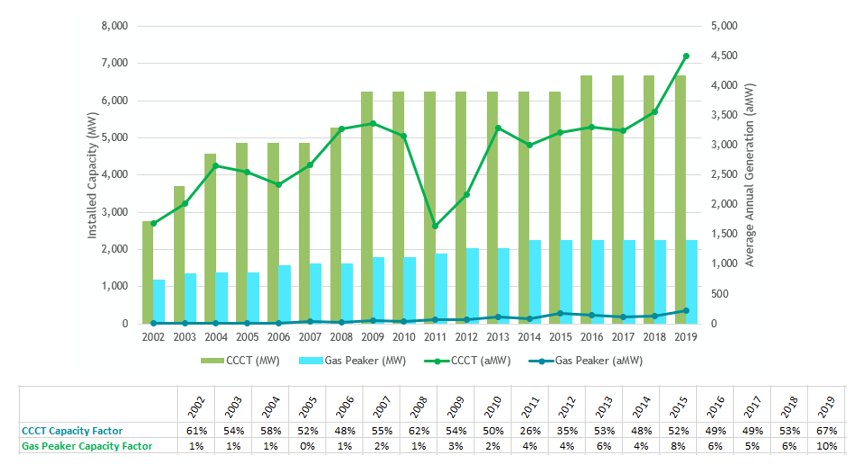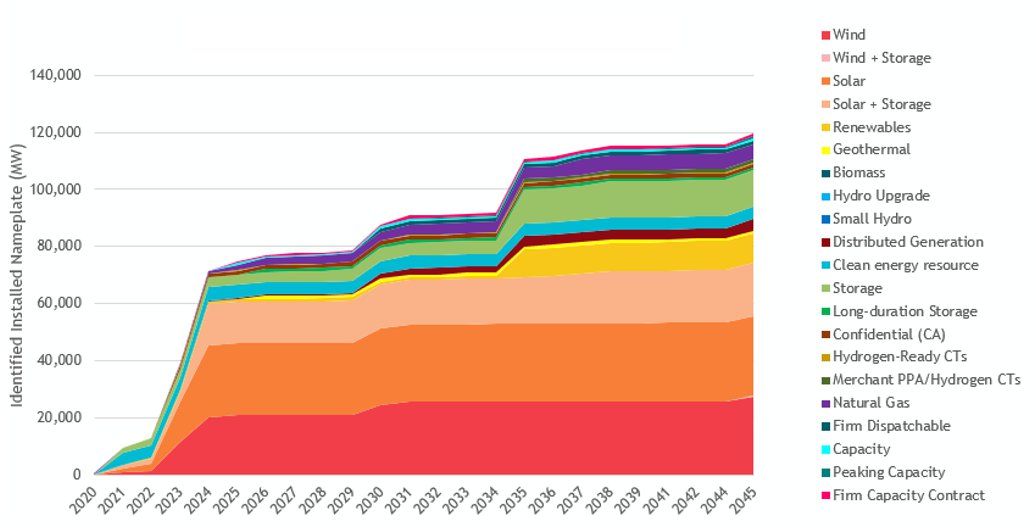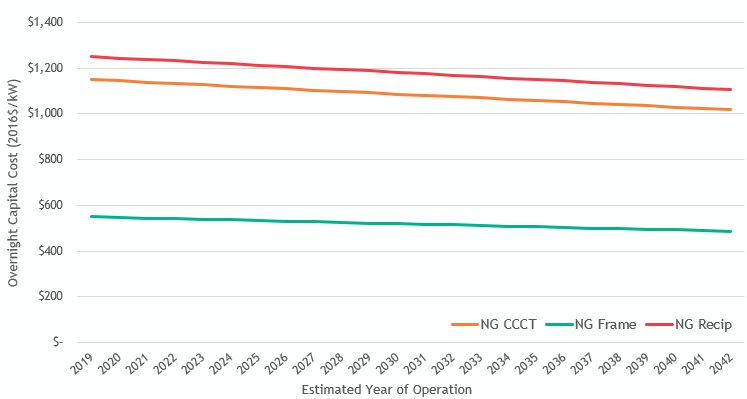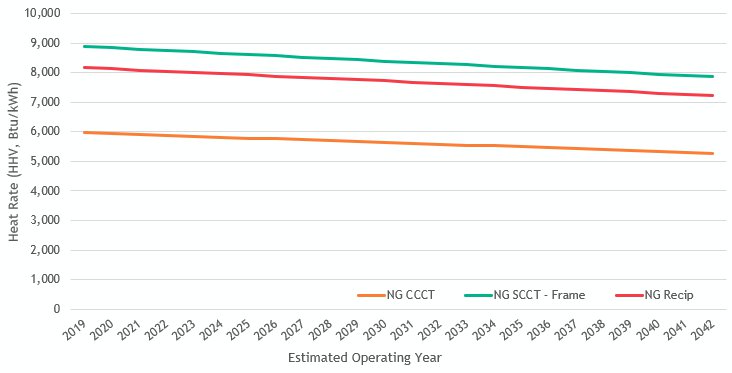Natural Gas
Jump to: Trends, Considerations, and Resource Potential | Description of Reference Plant
Natural gas technologies are proven and mature, yet also evolving to adapt to the needs of the new power system. As more must-run variable energy resources have entered the grid, it has become less important for gas resources to provide consistent, baseload generation. Rather, it has become increasingly important for gas resources to provide flexibility (fast start, ramping abilities) and greater efficiency (less fuel is combusted to generate more electricity). There are two major types of natural gas resources that the Council assessed for the 2021 Power Plan – combined cycle combustion turbines (CCCT) and gas peakers (which include various simple cycle combustion turbine (SCCT) technologies and reciprocating engines).
Combined cycle combustion turbines (CCCT) are highly efficient generating resources that can provide baseload and dispatchable power. A CCCT plant consists of one or more gas turbine generators each exhausting to a heat recovery steam generator (HRSG). The HRSG captures the exhaust heat and produces steam that is supplied to a steam turbine generator and condenser to produce additional electricity. The productive use of the gas turbine exhaust energy greatly increases the efficiency and output of CCCT plants as compared to simple-cycle gas turbines. This increasingly versatile technology can be used both as a replacement to retiring baseload coal power, and as a complementary firming power source to hydropower and renewable generation. The high efficiency of combined cycle plants coupled with the low carbon content of natural gas fuel results in the lowest carbon dioxide production rate of any fossil fuel generating technology. In the Northwest, operation of existing CCCT plants depends largely on the variability in annual hydro generation. During low water years, when hydro conditions are below average, thermal resources (primarily natural gas CCCT and coal units) tend to run at higher capacity factors to make up for the lower amount of hydroelectric power. During high water years, utilization of CCCT plants may decline. There are many other factors that may impact regional CCCT utilization, such as load, renewable power generation levels, plant outages, fuel prices, and wholesale electricity prices.
Gas peakers are generating units that can ramp up and down quickly to meet sharp spikes in demand. Newer, more flexible and efficient models can be used to follow the variable output of wind and solar resources. Because of the availability and abundance of hydropower, relatively few gas peakers have been constructed in the Northwest, compared to regions with a predominance of thermal electric capacity. In general, gas peakers produce at a much lower capacity factor when compared to CCCTs, running only when needed. Over the last twenty years, the capacity factor of the region’s gas peaker fleet has increased – averaging around 6% in recent years as compared to 1% in the early 2000’s.
PNW Natural Gas Fleet: Annual Generation vs. Installed Capacity

* Data source: Council’s project database
Simple-cycle gas turbines have been used for decades to help serve peak loads. A simple-cycle gas turbine generator plant consists of a combustion gas turbine (sometimes multiples) driving an electric power generator. The three primary simple cycle gas turbine technologies available today are frame, aeroderivative, and intercooled.
- Frame turbines are heavy-duty machines that are rugged and reliable. In the past, they have tended to have lower efficiency and less operational flexibility than other simple cycle technologies. However, as increased importance is placed on operational flexibility and ramping, newer classes of frame units are being developed to meet this need.
- Aeroderivative turbines are based on engines developed for aircraft propulsion and are characterized as light weight, highly efficient, and flexible. Aeroderivative are generally more expensive than frame turbines.
- Intercooled gas turbines are a hybrid of frame and aeroderivative technologies, designed for operational flexibility and high efficiency. They include an intercooler between compression stages to improve thermodynamic efficiency. The intercooler requires an external cooling water supply.
Reciprocating engine generating units consist of modular compression spark or spark-ignition reciprocating engines driving a generator. These engines can run on many different fuels, including natural gas, biogas, and oil. The technology has been widely used for biogas energy recovery, remote baseload power, and for emergency backup purposes. More recently, reciprocating engine generator plants have been used for peak load-following, and for shaping the output of wind and solar variable energy resources. These large internal combustion engines offer rapid response and quick start-up capability. Reciprocating engine generators also offer the best efficiency of the simple cycle gas technologies, especially during part-load conditions, and as a result they may run more often.
Natural gas as a fuel emits about half the carbon dioxide at combustion that coal does, and with natural gas being relied on more over coal, overall emissions from the generation of electricity are beginning to decline in the region. For more information on the Council’s strategy to account for carbon emission damages in the 2021 Power Plan, see the Greenhouse Gas Parameters here. In addition, the Council analyzed upstream emissions from methane during natural gas extraction and processing. For more information, see the upstream methane emissions analysis as well as the Council’s natural gas fuel price forecast.
Natural Gas Technologies Trends, Considerations, and Resource Potential
Jump to: Technology Trends | Cost Trends | Development Trends | Environmental Effects | Resource Potential in Region | Opportunities and Challenges
The following section describes high level trends in technology, cost, and development for natural gas technologies. In addition, it identifies resource potential in the region, opportunities and challenges, and environmental effects.
Manufacturers of natural gas technologies are chasing greater performance (net output), efficiency (lower heat rates), and greater flexibility (ability to ramp up and down quickly, for example). This has led to the phase out of older more traditional simple cycle gas turbines - that were primarily used on occasion to meet peak load - in favor of technologies that can react, adapt, and provide additional ancillary services and value to the grid.
Overall, gas technology costs have largely remained the same over the past several years with the exception of simple cycle frame units. There have been significant cost declines in natural gas frame units - operated in simple cycle mode as a gas peaker – which can be attributed to greater nameplate capacities and performance (output), lower equipment costs, and increased competition among engineering, procurement, and construction (EPC) contractors for the limited amount of new builds (thus contractors bid low in order to secure contracts).
There are sizable variations in the cost estimates for each technology, as evidenced by the figures below that capture cost estimates from utilities, manufacturers, and reports. This is largely due to equipment choices (selecting wet vs. dry cooling, adding oil back-up capability, fuel compressors, inlet air chilling for plants operating at high temperatures, bypass stacks to run a CCCT independent of the HRSG, clutches on gas peakers to provide voltage support and reactive power to the grid, and supplemental duct firing, as a few examples) that can have a considerable effect on the capital cost of a project – sometimes up to 30% - but also the overall performance and capability of the project. In addition, for frame turbines, there are large differences in capacity when you move from one class to another. For example, in the Seventh Power Plan, the Council’s reference plant was based off of an F-class frame turbine. For the 2021 Power Plan, the reference plant is based off of the more advanced (more flexible) H-class frame turbine which has a much greater capacity. The H-class is much less expensive in terms of capital cost ($/kW) because it is capable of producing significantly more electricity. It is incumbent on the utility or project owner to assess the needs of their respective balancing area or customer(s), while complying with mandated regulations, and make the most cost-effective equipment selections for their system.
The figures below show the data plots and analysis that was used to develop the 2021 Power Plan reference plant cost estimates for natural gas. Note that these figures capture data from various project capacities, configurations, and technology vintages. See the cost workbooks for more details.
Overnight Capital Cost of Natural Gas Combined Cycle Combustion Turbines

Overnight Capital Cost of Natural Gas Simple Cycle Combustion Turbines – Frame

Overnight Capital Cost of Natural Gas Reciprocating Engines

Across the entire United States, from 2016 to the end of 2019, roughly 48,000 megawatts (nameplate capacity) of new natural gas resources were developed and placed in service. The majority of this new capacity – by far – were combined cycle combustion turbines (CCCT). However, the story is very different in the west, with only about 5% (2,400 megawatts) of this new capacity located across the western interconnect. Contrary to the trends elsewhere in the nation, the majority of new development in the west were gas peakers in California and Arizona, with only one CCCT in the Pacific Northwest (Carty Generating Station).
Through 2027, about 80,000 megawatts of new natural gas nameplate capacity were planned across the United States (based on data pulled in 2019 from S&P Global). Only 10% of that planned potential is located within the western interconnect (WECC) and the majority are in the eastern United States in the RFC and SERC regions of NERC. While planned resources do not mean that these projects will proceed, they can provide a general idea of what the future could look like. While there are renewable portfolio standards in some of the eastern states in the RFC and SERC, they tend to be less aggressive than the west and there are no clean energy regulations. This definitely plays a role in future generating resource options in these areas.
Planned New Natural Gas Additions, by NERC Region

* Data sourced from S&P Global, 2019
In the latest round of utility integrated resource plans (IRPs) throughout the WECC (see Council analysis and presentation from June 2021), it is clear that utilities are grappling over the future role of new natural gas plants as coal plants retire and many states and utilities have adopted clean energy policies and goals. Of the data compiled from the IRPs (which covered about 70% of the US portion of WECC), only a small portion of the future new resources identified is natural gas (the purple shaded area towards the top). While IRPs represent a moment in time and are subject to change as they are analyzed every two years, it definitely shows a heavy preference for renewable and carbon-free new resources. Of the new natural gas identified, about 30% were combined cycle combustion turbines and 70% were gas peakers. Several utilities are exploring dual-fuel CCCTs and peaking units, with the idea that the plants can combust natural gas for the near future and then switch to alternative fuels (hydrogen, biodiesels) down the road.
Identified Potential New Resources - ~70% of the U.S. portion of WECC IRPs

See the Environmental Effects of Generating Resources for a high-level summary of some of the primary environmental effects of natural gas technologies. For an in-depth description of the lifecycle impacts associated with electricity generation, see Appendix I of the Seventh Power Plan.
All of the new natural gas technologies considered and assessed by the Council for the 2021 Power Plan are assumed to comply with existing environmental regulations governing air and water emissions, siting regulations, waste disposal, fuel use (extraction and production), and fish and wildlife protection and mitigation costs when quantifiable and directly attributable to the new resource. For natural gas technologies, this is most obviously captured and quantified in the cost of equipment and therefore accounted for in the reference plant cost estimates. For more information, see the section on Federal Statutes and Regulation Updates and the Methodology for Determining Quantifiable Environmental Costs and Benefits and Due Consideration.
Resource Potential in the Region
With the Clean Energy Transformation Act (CETA) in Washington and the House Bill 2021 in Oregon mandating 100% clean energy supplies by 2045 and 2040, respectively, it could be difficult to license and develop new gas plants within those states. However, in Idaho and Montana, there are no regulations prohibiting new natural gas development. In response to a competitive solicitation process for long-term capacity resources, Northwestern Energy announced in April 2021 plans to develop a 175-megawatt natural gas reciprocating engine plant in Laurel, Montana. If constructed, it could be in operation in 2023.
There are significant coal unit retirements occurring and planned across the region and the western interconnect over the next decade – to what extent will natural gas be a part of the replacement resources that help play a role in the new dynamic, carbon-constrained energy system? The future role – and the extent of it - of new natural gas plants within the region’s power system is yet to be determined. With clean energy policies enacted in Oregon and Washington, new natural gas development may only be realistic in Idaho and Montana.
Natural gas technologies are able to provide consistent energy generation as well as flexible capacity, two attractive attributes to any power system. Costs for some technologies are competitive with other resource alternatives – though not as cheap as solar and wind. There may be opportunities for manufacturers to explore dual fuel technologies to enable the combustion of natural gas in the near-term and alternative less-carbon intensive fuels (like hydrogen and biodiesel) in the future.
Description of Natural Gas Reference Plants
For the 2021 Power Plan, the Council developed three natural gas reference plants, all located east of the Cascades – a combined cycle combustion turbine (CCCT), simple cycle combustion turbine (SCCT), and a reciprocating engine (recip). There are several options for a simple cycle combustion turbine technology. After discussions with the GRAC, the Council settled on the frame technology because it is the least expensive option. While it may not be as flexible as the other gas peakers, there are similar enough operating characteristics between them all. Though the Council only included the frame SCCT in its modeling, staff did provide analysis and reference plant attributes for a SCCT aeroderivative and intercooled unit as well. See the workbook for data on these options. All natural gas reference plants utilize technologies and equipment that comply with federal environmental regulations.
The CCCT natural gas reference plant is based off of the General Electric 7HA.02 frame unit in a configuration that includes one gas turbine and heat recovery steam generator (HRSG) to one steam turbine (1x1). This reference plant utilizes dry cooling (as opposed to wet cooling) and is a single fuel only (not dual fueled to allow for oil back-up or alternative fuel). The nameplate capacity is 545 megawatts, taking into account altitude and ambient temperatures in an eastern location. The reference plant assumes all surrounding infrastructure and necessary equipment are included in the cost, for example all buildings, step-up transformers, switchgear and interconnection facilities, and security, control, and maintenance facilities. While some CCCTs utilize duct firing to increase output from the steam generator, this reference plant does not assume this feature. Emission controls in compliance with federal regulations include dry low-nitrogen oxide burners and selective catalytic reduction for nitrogen oxide control and an oxidation catalyst for carbon dioxide and volatile organic compound control.
The SCCT natural gas reference plant is based off of the General Electric 7HA.02 frame unit with one turbine generator (1x0 configuration). The nameplate capacity is 360 megawatts, taking into account altitude and ambient temperatures in an eastern location. The reference plant assumes all surrounding infrastructure and necessary equipment are included in the cost, for example all buildings, step-up transformers, switchgear and interconnection facilities, and security, control, and maintenance facilities. Emission controls in compliance with federal regulations include dry low-nitrogen oxide burners and selective catalytic reduction for nitrogen oxide control and an oxidation catalyst for carbon dioxide and volatile organic compound control.
The reciprocating engine natural gas reference plant is based off of the Wärtsilä 18V50SG gensets. The reference plant includes 12 gensets at about 18 megawatts each, for a plant nameplate capacity of about 220 megawatts. Emission controls in compliance with federal regulations include selective catalytic reduction for nitrogen oxide control and an oxidation catalyst for carbon dioxide and volatile organic compound control. The reference plant assumes all surrounding infrastructure and necessary equipment are included in the cost, for example all buildings, step-up transformers, switchgear and interconnection facilities, and security, control, and maintenance facilities.
Natural Gas Technologies: 2021 Power Plan Reference Plants
| Reference Plant | Natural Gas – CCCT East | Natural Gas – SCCT East | Natural Gas – Recip East |
| Technology Type | GE 7HA.02, Dry-cool, Single fuel | GE 7HA.02 Frame | Wartsila 18V50SG gensets |
| Configuration | 1 x 1 | 1 x 360 MW | 12 x 18MW |
| Nameplate Capacity (MW) | 545 MW | 360 MW | 220 MW |
| Location | East of the Cascades | East of the Cascades | East of the Cascades |
| Technology Vintage Year | 2019 | 2019 | 2019 |
| Average Capacity Factor | – | – | – |
| Round-trip Efficiency | – | – | – |
| Heat Rate – HHV (Btu/kWh) | 5973 | 8890 | 8176 |
| Economic Life (Years) | 30 | 30 | 30 |
| Tax Benefits | – | – | – |
| Financial Sponsor | IOU | IOU | IOU |
| Development Period (Yrs) | 2 | 2 | 1 |
| Construction Period (Yrs) | 2 | 1 | 1 |
| Earliest In-Operation Date | 2021 | 2021 | 2021 |
| Overnight Capital Cost ($/kW) | $1,150/kW | $550/kW | $1,250/kW |
| All-in Capital Cost ($/kW) | $1,272/kW | $580/kW | $1,315/kW |
| Fixed O&M Cost ($/kW-yr) | $10/kW-yr | $5.50/kW-yr | $5/kW-yr |
| Variable O&M Cost ($/MWh) | $3/MWh | $6.50/MWh | $5/MWh |
| Transmission | BPA P2P Long-term Firm | BPA P2P Long-term Firm | BPA P2P Long-term Firm |
| Deferred Transmission and Distribution ($/kW-yr) | – | – | – |
| Maximum buildout (MW) | 5,450 MW (10 ref plants) | 3,650 MW (10 ref plants) | 2,200 MW (10 ref plants) |
*All costs in 2016 year dollars. For more details and definitions of resource attributes, see Definitions of Reference Plant Components.
Fuel: When calculating the levelized cost of energy, fixed and variable fuel costs are included for each natural gas reference plant. The fixed-fuel cost estimates for new natural gas power plants are expressed in a $/kW nameplate capacity basis. It is assumed that a new plant would contract for firm capacity on the long-haul pipeline that is delivering its gas. The cost represents the cost to reserve incremental firm capacity on the pipeline and is calculated using the specific pipeline tariff. The variable fuel cost ($/MMBtu) is primarily the commodity cost for the product itself – the cost to purchase the gas far upstream plus some variable pipeline charges to move it to the plant. For data on the fixed and variable fuel costs applied to the reference plants in a LCOE calculation, see the MicroFin workbook. For information on the derivation of the cost estimates, see the natural gas price forecast and fixed fuel cost estimate for new gas power plants.
Maximum buildout: The maximum buildout potential for natural gas reference plants in the 2021 Power Plan aligns with a rough judgment of gas pipeline capacity on the eastside.
Forward capital cost curves: Each of the natural gas reference points utilize mature technologies and therefore there are not any major cost improvements anticipated over the course of the power plan. A forward capital cost de-escalation rate of 0.05% annually has been applied to the costs of all natural gas reference plants to reflect modest gradual price improvements. By the end of the planning horizon in 2042, all natural gas reference plant capital, fixed O&M, and variable O&M costs are estimated to have improved (decreased) by 12%.
Natural Gas Reference Plants – Capital Cost (2016$/kW)

Forward heat rate improvements: A modest 0.05% annual heat rate multiplier is applied to each of the natural gas reference plants. This assumes gradual improvements to the efficiency of the gas plant technologies over the course of the power plan. By the end of the planning horizon in 2042, all natural gas reference plants are estimated to have improved (decreased) heat rates by 12%.
Natural Gas Reference Plants Forward Heat Rate Improvement

More information: For background analysis, see the initial presentation on onshore wind reference plants from the October 2019 GRAC meeting. Please note that some of the material in the presentation may have been updated between that meeting and the draft plan. In addition, see the capital/FOM/VOM cost workbooks for all resource reference plants as well as MicroFin for supplementary inputs and analysis.


